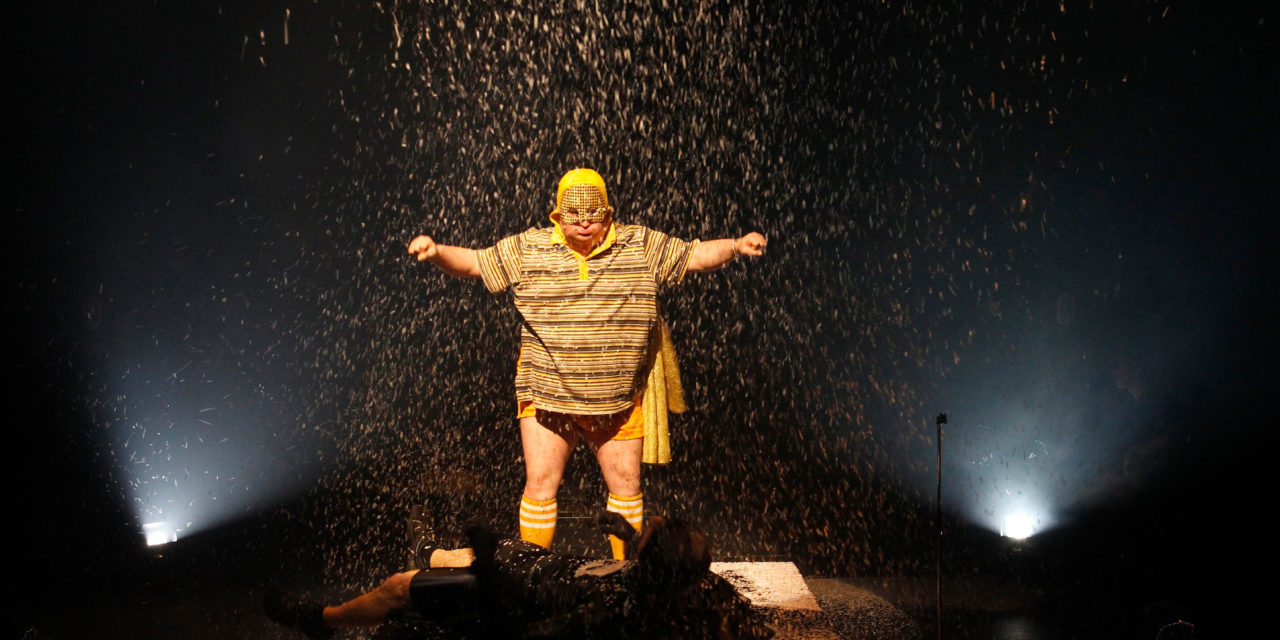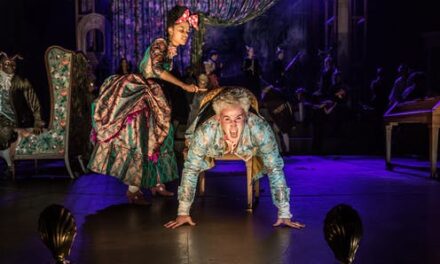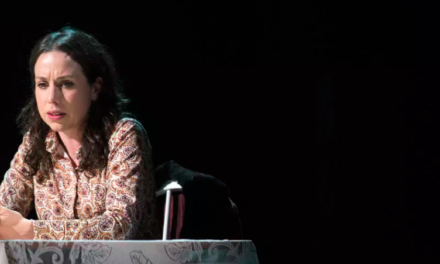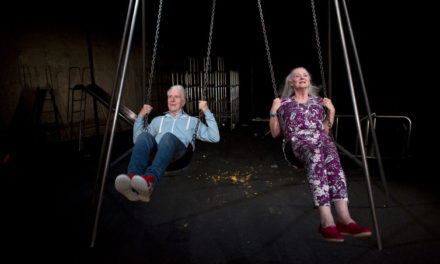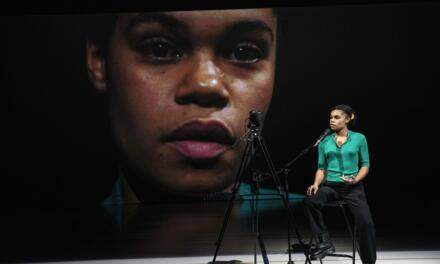Over the last 20 years, the development of technology in performance has made us question what is meant by “human presence” on stage when the body, the voice and the perceived agency of the actor are not the core of the performance, but merely components of it. How is this reconsideration of the agency of the human actor affected by the involvement in performance of people with disabilities, many of whom themselves operate as hybrid bodies, making use of prostheses, wheelchairs, and speech synthesis machines? What are the aesthetic and political implications of the presentation of such hybrid bodies in performance?
New aesthetic challenges and possibilities emerge from the confrontation of such performers with assumed norms of economy and elegance in movement, clarity of speech, and notions of agency implicit in certain types of virtuoso performance. The performance of people with disabilities faced with technology is political. It is so not only in terms of the specific politics of the perception of disability in performance, encompassing accusations of exploitation and expectations of inclusion or emancipation but also in revealing the shared vulnerability and precariousness of the contemporary subject–a dis-ability or disempowerment that confounds the binary of ability and disability. Theatrical performance by people with disabilities is constantly in dialogue with “non-disabled” performance: at times a mirror image, at times as imago or distorted reflection.1
I wish to consider some specific moments of performance taken from the work of Back to Back Theatre, an ensemble of performers perceived to have intellectual disabilities. These involve the performer Sarah Mainwaring, whose disability is deployed in performance faced with and in confrontation with specific techne of theatricality. At the end of Super Discount (2013) she interacts with a relatively simple technological object: a hand-held microphone that she attempts to place in its stand. Her distinctive performance of this action raises questions of how technology may be used in theatrical performance to facilitate, aestheticize or problematize the participation of performers with disabilities. In the hands of a stage-hand, the clipping of a microphone to a stand might well be an unremarkable action, a kind of “non-matrixed performance.” 2 In the hands of Sarah Mainwaring the “embodied difference” 3 of her disability transforms that task into something remarkable.
As spectators, we see her attempts toward the completion of this action and the involuntary movements that, despite herself, take her away from it. We can clearly see what she is intending to do, what she is moving toward doing. In advance of its completion, we know the function the movements are intended to perform, yet her progression toward completing the action is threatened with its undoing. Her movements–both intentional and unintentional–seem to take her at times three steps forward and two steps back, and at times two steps forward and three steps back. Due to the fact that the microphone is switched on, we can also hear her struggle to complete the action.
Her performance of this action calls attention to itself, but it is pointing to both her inability to perform the action, and the theatricality of that inability. The spectator is caught between measuring Sarah’s distinctive movements against a norm of simplicity, economy, and elegance–according to which criteria she would be found deficient–and in finding what is fascinating, beautiful, and compelling in the embodied difference of her movements. The time she takes to (eventually) complete this action is different from what might be expected. There is a durationality about her actions. But how has this durationality been deployed in performance? It is a kind of de facto durationality. Presumably, Sarah Mainwaring has no choice over the duration of her actions; this is how she moves. It is the particular theatrical dispositif of the production that chooses to display her distinctive durationality in performing this action. In the time that they are not used to waiting for such an action to be completed, the spectator is invited to question what is being performed by the allocation of this task to Sarah Mainwaring: whether her “embodied difference” is being curated, displayed or exploited. Super Discount, like much of Back to Back’s recent work, invites such spectatorial anxiety in an interrogation of the processes of perceiving–particularly the perceiving of disability.
One question that emerges is whether the encounter of Sarah Mainwaring and her distinctive habits of movement with an elementary object of stage technology is in some way aestheticizing her disability. This is certainly at stake in Jason Blake’s response to these moments in his review of the production in the Sydney Morning Herald: “Sarah Mainwaring’s palsy turns the task of clipping a microphone into its stand into a dance that draws you to the edge of your seat.” 4
Blake assigns grammatical agency to her disability. Her “palsy” is an agent that transforms the basic task into a performance that both shapes space and time aesthetically–“a dance”–that is compellingly theatrical, that “draws you to the edge of your seat.” This is, however, not the theatricality of physical virtuosity nor the virtuosity of the manipulation of theatrical techne by the performer. Sarah Mainwaring’s “palsy” achieves such theatrical effect and affect by catching the spectator somewhere between anticipation of the completion of her actions and anxiety at the possibility of their failure. Perhaps the spectator’s mirror neurons are tracing synaptic paths completing the action for her, while at the same time other neurons may be firing in empathy for her disability or inability. We may be on the edge of our seat experiencing both frustration and empathy, in “the paradoxical situation where the spectator feels (or can feel) an aesthetic pleasure by living an anxiety-inducing relationship.” 5
There is, of course, an underlying irony in the exposure of, and aestheticizing of her disability in the performance of actions intended to control an instrument designed to facilitate or augment verbal communication. Her action with the microphone both reveals part of the hidden labor of performance and becomes a performance in itself, with the object in Sarah’s hands taking on her distinctive patterns of movement–movement that produces sound, but sound that is non-verbal. This irony is typical of Back to Back’s attempts to deploy disability as theatricality and to utilize and at the same time render problematic theatrical technology designed to assist or facilitate the communication of performers with disabilities.
In the wider context of Super Discount, Sarah Mainwaring’s actions of placing the microphone in its stand at the end is both an undoing and a completion of an action she performed at the beginning of the production: taking it out of its stand, undertaken with a similar struggle and a similarly unexpected duration. Her distinctive performance of these actions, therefore, frames the whole narrative. The piece itself is a multi-layered, provocative, and humorous investigation by four male characters of the comic book superhero, a figure who would be incomplete without their fatal flaw or weakness. Super Discount questions the dis-counting of people with disabilities from inclusion in what is termed the community, and from aesthetic and political representation. The conclusion of the superhero strand of the narrative is a confrontation between superhero Mark Deans, a performer with Down’s Syndrome who has a somewhat restricted access to spoken communication, and villain David Woods, a performer without disabilities. This takes place within the lo-tech minimalism of the mise-en-scène in a simulacrum of a snowstorm on top of a table. Mark Deans vanquishes the villain by emitting an almighty roar of power into the handheld microphone, which amplifies and reverberates his non-verbal sound. He then stands in triumph astride the villain lying prone on the table. The affective charge of what follows is described in an online review by Grehan and Eckersall:
“As the other actors begin to strike the set around him, Mark, our superhero, can’t get down from the table. He calls to another of the cast–Sarah Mainwaring–for help. The fragility of our existence is captured in these closing moments.” 6
As Sarah Mainwaring offers Mark Deans her shaking hand to facilitate his descent from the table, a shift occurs from the previous scene of the confrontation between superhero and villain, characterized by Grehan and Eckersall as a “moment resplendent with theatricality and drama,” 7 to what feels like a different mode of performance as Sarah Mainwaring helps Mark Deans down off the table, and, in the closing moments of the production, replaces the microphone in its stand in her distinctive way.
While Sarah Mainwaring’s actions are significant and remarkable, in the male world of the play they are also marginal. It could be argued that her role is marginal as parergon, defined Josette Féral as:
“in the Derridean sense of the term to mean the frame, and consequently what in the subject is most important, most hidden, most repressed, yet most active as well.” 8
Within the context of Super Discount this marginality as parergon is problematic, given the piece’s division of labor and visibility in terms of gender: the men argue and fight the battles, the sole woman seen by the audience sets up and passes them the microphone. This marginality needs to be put into the context of the wider oeuvre of Back to Back. The company operates with an ongoing commitment to a small acting ensemble that are given specific challenges in different productions and, in addition, each production is in dialogue with the productions that preceded and follow it. The function of the microphone in Super Discount and Sarah Mainwaring’s manipulation of it connects with an earlier production, Food Court in which male actors are more marginal: they conduct sound checks and operate boom microphones in a narrative in which female actors are the central characters, none more so than Sarah Mainwaring. She “plays dumb” through most of Food Court but then at the end is given voice in a highly mediatized way that is important to consider in terms of the interaction of performers with disabilities and technology in performance.
In Food Court (2007) Sarah Mainwaring plays Leslie, a character who is bullied for being fat by two characters played by much larger female actors with Down’s Syndrome. Leslie is forced to strip naked and dance for them while a crowd of onlookers emerges to scrutinize her. The two women then enact a physical assault on her. Throughout the piece she does not speak and is mocked and abused for not doing so. She is banged on the head and poked in the chest with a boom microphone to get her to produce some kind of sound. The boom microphone is played around her lips and inserted into her mouth in a humiliating process of penetration.
When she finally does speak, it is with the words of Caliban’s speech from Act III, Scene 2 of Shakespeare’s The Tempest: “Be not afear’d the isle is full of noises.” The speech is presented in a highly mediatized dispositif. She delivers the speech into a microphone that not only amplifies her voice but manipulates it: at times causing it to reverberate or altering its pitch. At the same time, the words of the text she is speaking are projected onto the screen of the transparent inflatable in which she stands and onto the still visible back wall of the theater. Each word or phrase of the text “arrives” in a distinctive way, in juggling clusters of letters and phonemes, first appearing at the level of the performer on the stage and then journeying up the proscenium to the position of surtitles. The captioning or surtitling is animated and voice-activated using software specifically developed for the production. The director, Bruce Gladwin, described what was intended by the use of this particular technology:
She has an ABI–an acquired brain injury–and there’s a quality of staccato delivery. She’s always starting and beginning and not finishing words and needing a visual reference to get the word formed. So she would have two or three attempts at it and the word would float up or the letters would float up, jumbled, and as they get closer to the line they assemble themselves, but if she doesn’t deliver it with enough force they float back down […]. It’s like a visual representation of her speech pattern. 9
She in fact says, “Be. Be not. Be not afear’d. Be not afear’d the isle is full of noises.” As she struggles to enunciate the words and strains to form phrases, the letters and words of the captioned text “bounce around, seeming fragile and isolated as if they are stuttering or left hanging in space.” 10 This presents at once a theatrical form of Derridean “différance,” a representation of her incapacity to breathe or speak the Shakespearean line in its allotted duration unaided by technological intervention, and a strangely affecting and beautiful theatricalization of her incapacity.
Captioning is generally used to aid the comprehension of an audience, but in this case, as is indicated by Gladwin’s comments, it is also used to aid the performer. Moreover, the highly mediatized presentation of her distinctive delivery of the speech raises the question of the agency of her voice. From where is the speech coming? As a text, it is coming from a classic of the Western canon of dramatic theater, couched in the baroque conceits and lexical innovation of the English Renaissance. In confrontation with this highly theatrical speech, Sarah Mainwaring’s way of speaking, her breathing and phrasing, is an awkward match. The beautiful but poignant words of the abused, stigmatized and monstrous Caliban placed in the mouth of Sarah Mainwaring connect with a history of teratology and freakery in the presentation of people with disabilities. She is not in a position to deliver the oft-cited words with the command of diction, articulation, and inspired breathing of a conventionally trained actor. The production utilizes technology that would appear to be both assistive and aesthetic to her vocal delivery. This technology appears both to facilitate the accommodation of her distinctive breathing and articulatory patterns and to add aural and visual colors and intensities that theatricalize the delivery of the speech. The production, however, encourages the audience to continue questioning from where the voice is coming, provoking a complex interrogation of the perception of “voice” in the sense of agency. Which comes first: Sarah Mainwaring’s articulations or the captions? How are the captions animated? Are they genuinely voice-activated, or do they slightly precede the voice, supporting her faltering articulation as much as alleviating the audience’s potential misapprehension of what she is saying? The production leaves these questions deliberately open.
The notion of what “voice” is, in the technological process of voice activation, is complicated first by the fact that this is such a well known, cited, and recited speech, and then further by the fact that the “voice” only emerges in an intermedial process in which Sarah’s habits and patterns of articulation are in play with the manipulations of the software, which are themselves playing off the acoustic manipulation of the sounds from her vocal tract undergoing amplification, reverberation, and pitch modification. Theron Schmidt has characterized this aspect of the facilitation and questioning of the agency of voice in Food Court as producing an “un-locatable speech-act.” 11 The production explores at a deeper level Bruce Gladwin’s comment that this is the visual representation of Sarah’s speech pattern. It both interrogates what constitutes Sarah’s speech pattern and renders problematic how her voice is considered to be “her”: whether her voice is determined by her ABI or by how her speech is mediated through technology. The performance of her voice, and what constitutes her performance is a complex confrontation between her disability and the dispositifs of theatricality and technology. What emerges is a form that exhibits what Catherine Malabou has termed plasticity: the synapses of performer and audience are still wiring and firing, 12 but in unexpected ways, as the contingencies of the presence of a performer with disabilities confront the formal constraints of technology. This confrontation exhibits plasticity in that the technology does not overcome the disability, nor vice-versa, but both are changed and rendered different in the encounter. The question remains open as to whether the contingencies of the presence of the performer with disabilities are the same as and/or different from those of any other non-disabled body, or whether the person with disabilities is “human but more so” 13 in the way that disability as a cultural trope is often associated with an extremity that both delimits and constitutes humanity, occupying a position of liminality that is both sacred and sacral.
In another section of Food Court, Sarah Mainwaring shakes hands with one of her bullies, an action that is part of a social code of competence, but after the other’s hand is withdrawn, Sarah’s hand continues to shake in a kind of visual pun that undermines the assumed meaning of that social code. Similarly, at the end of the Caliban speech that is delivered in all its mediatized power, she stands center stage, her hand still shaking, but it is genuinely and deliberately unclear whether the shaking is indicative of emotion or of dystonia.
In Performance And Theatricality: The Subject Demystified, Josette Féral refers to a kind of deconstruction of theater by performance: “an art form whose primary aim is to undo ‘competencies’ (which are primarily theatrical). Performance readjusts these competencies and redistributes them in a desystematised arrangement.” 14 Disability shares with Féral’s specific characterization of performance an undoing of competencies. The recent participation of people with disabilities in contemporary performance generates both a theatricality of incapacity and an incapacity as theatricality. In the encounter between people with disabilities and the techne of theater, what emerges is akin to Féral’s conception of theatricality in the sense of a dialectical interaction of theater and performance “each undoing the other and thus establishing a wavering field of reception in the tension between them.” 15 In Food Court it is unclear whether the production beautifies and theatricalizes Sarah Mainwaring’s voice and movement, or reveals, in Schmidt’s phrase, an “un-locatable speech-act” and un-locatable movements in the shaking of her hands. The deployment of her presence flickers and wavers between theatrical representation and the presentation of performance–between theatricality and incapacity.
What constitutes Sarah Mainwaring’s disability is a moot point. Jason Blake in the Sydney Morning Herald refers to Sarah Mainwaring’s “palsy,” but this is a misreading: she does not have palsy but an acquired brain injury. Disability is itself in many instances in the misreading of the beholder. It is (mis)read as a deficient performance and a performance of deficiency, and this (mis)reading is deeply inscribed in cultural tropes. The word palsy itself recalls a medieval discourse of divine judgment meted out onto the body as a mark of punishment for transgression. In the Speculum Christiani of 1450 this is articulated as: “God putte palsi or quakynge of hede [L. tremorem capitis] vpon Kayn.”16 Sarah Mainwaring’s disability, her ABI, gives her the appearance of somebody with cerebral palsy. She has a lopsided stance, an unsteady gait and a tremulous manner of speaking; all of these descriptors confound (negative) aesthetic and moral judgment.
Disability outside of a theatrical space has a habit of rendering such spaces theatrical, since it is a kind of performance in the so-called everyday that is remarkable: disability causes a “commotion” as Sandahl and Auslander characterize it. In theatrical performance, therefore, disability already comes with its own baggage as performance. An audience may perceive disability as itself a performance and at the same time as an “irruption of the real” 17 in performance. Back to Back’s deployment of Sarah Mainwaring and her disability is complex. She has a brain injury, which is a kind of intellectual disability, but one that impairs her communicative rather than her cognitive abilities. Yet she is part of an ensemble that is known as an ensemble of actors with intellectual disabilities (performers with Down’s Syndrome and autism). In Food Court she is treated by other performers as if she is intellectually disabled or “dumb;” in Super Discount she inhabits the margins apparently as a glorified if unsteady stagehand, yet she herself has had a long independent career as a performance artist. Performers like Sarah Mainwaring and others in the Back to Back ensemble “play at” being intellectually disabled or “play up” to expectations of intellectual disability, and by doing so confound a non-disabled audience’s anxieties over the agency of the performers with disabilities. This is often a self-reflexive concern: those who are anxious about the agency of others reveal their anxieties about their own agency.
Questions of the agency of performers with disabilities in performance overlap with concerns about what constitutes the human actor’s agency in forms of theatrical performance that are increasingly technologically mediatized. To return to Sarah Mainwaring’s manipulation of the microphone in Super Discount, it is a kind of paradigm of the interaction of disability and technology in performance. Her actions appear fragile or even disempowered, and go on long enough for an audience to fear that the theatrical contract may be broken. Grehan and Eckersall, referring to other moments in Super Discount, state appositely that: “we are on the verge of questioning the limitations of theatre itself.” 18 Theater proves to be as fragile as Sarah Mainwaring’s grasp on completing the action of clipping a microphone to its stand. This fragility at the end of Super Discount has been present since the opening of the piece, in the first words we hear spoken, the words of Artaud: “It is at the centre […] the fragile, fluctuating centre […] that can never be reached.” 19
Both the fragility of theatrical representation and the underlying impossibility of the project of representation emerge in their confrontation with disability, itself an unstable category. This recognition of fragility is potentially an acknowledgment of a fellow feeling, a mutual, corporeal fragility: an acknowledgment of the temporary able-bodiedness that is common to people with and without disabilities. It is a recognition that abilities and capacities are dependent upon the support of others–or even the suppression of others–and the support of, and struggle with, non-human objects and techne amidst a precarious ecology. Disability faced with technology in performance is a form of incapacity theatricalized and incapacity in theatricality. It is a dance that keeps you on the edge of your seat, the choreography of which is a choreography of contingency, emerging from and operating across all bodies present.
This article was originally published on archee.qc.ca. Reposted with permission. Read the original article.
Notes
1. I refer here to Lennard Davis: “the disabled body is a direct imago of the repressed fragmented body, a hallucination of the mirror stage gone wrong” (Davis, Lennard J. “Nude Venuses, Medusa’s Body and Phantom Limbs” in Mitchell, David T. and Sharon L. Snyder (ed.), The Body and Physical Difference: Discourses of Disability. The University of Michigan Press, Ann Arbor, 1997, p. 51- 70, p. 60.)
2. Kirby, Michael. “On Acting and Not-Acting” in Zarrilli, Phillip B. (ed.), Acting (Re)Considered: A Theoretical and Practical Guide, Routledge, London, 1995, p. 40-53, p. 41.
3. Kroß, Kati. “Christoph Schlingensief’s FreakStars 3000: ‘Consistently Abused and Forced to Portray Disability’,” trans. Christoph Nöthlings, in Umathum, Sandra and Benjamin Wihstutz (ed.), Disabled Theater, Diaphanes, Zurich, 2015, p. 179.
4. Blake, Jason. “Super Discount a Swirling Test of Heroism,” Sydney Morning Herald, 12 December 2013, Web.
5. Couchot, Edmond. “Une inflexion inattendue de l’évolution: autonomie et esthétique,” Keynote Speaker Presentation, “Corps en Scène: L’Acteur Face Aux Ecrans / Bodies on Stage: Acting Confronted by Technology,” 3-5 June, University Sorbonne Nouvelle-Paris III.
6. Grehan, Helena and Peter Eckersall. “Review: Super Discount by Back to Back Theatre,” The Conversation, 19 November 2013.
7. Ibid.
8. Féral, Josette. “Performance and Theatricality: The Subject Demystified,” trans. Terese Lyons, in Murray, Timothy (ed.), Mimesis, Masochism and Mime: the Politics of Theatricality in Contemporary French Thought University of Michigan Press, Ann Arbor, 1997, p. 170-181, p. 178.
9. Gladwin, Bruce and Gough, Richard. “Making Room for Elephants: Bruce Gladwin in Conversation with Richard Gough” in Grehan, Helena and Peter Eckersall (ed.), We’re People who do Shows: Back to Back Theater:Performance, Politics, Visibility, Performance Research Books, Aberystwyth, 2013, p. 230-257, p. 243.
10. Grehan, Helena. “Responding to the ‘Unspoken’ in Food Court” in Grehan, Helena and Peter Eckersall (ed.),We’re People who do Shows: Back to Back Theatre: Performance, Politics, Visibility, Performance Research Books, Aberystwyth, 2013, p. 104-114, p. 110.
11. Schmidt, Theron. “Acting, Disabled: Back to Back Theatre and the Politics of Appearance” in Jürs-Munby, Karen, Jerome Carroll and Steve Giles (ed.), Postdramatic Theatre and the Political: International Perspectives on Contemporary Performance, Bloomsbury, London, 2013, p. 189-207, p. 207.
12. Malabou, Catherine. “Performance and Power: An Interrogation,” Keynote Speaker Presentation, “Theatre, Performance and Philosophy Conference,” University Sorbonne Paris I, 27 June 2014 (unpublished).
13. I refer here to James Berger who in turn is citing Matthew Belmonte’s “Human but More So: What the Autistic Brain tells us about the Process of Narrative” (Berger, James. The Disarticulate: Language, Disability and the Narratives of Modernity, New York University Press, New York, 2014, p. 16.)
14. Féral, Josette. “Performance and Theatricality: The Subject Demystified,” trans. Terese Lyons, in Murray, Timothy (ed.), Mimesis, Masochism and Mime: the Politics of Theatricality in Contemporary French Thought University of Michigan Press, Ann Arbor, 1997, p. 170-181, p. 179.
15. Carlson, Marvin. “The Resistance to Theatricality,” SubStance, vol. 31, no.2-3, Issue 98 / 99, Special Issue: Theatricality, 2002, p. 238-250, p. 245.
16. OED online.
17. Lehmann, Hans-Thies. Postdramatic Theatre, trans. Karen Jürs-Munby, Routledge, London, 2006, p. 99.
18. Grehan, Helena and Peter Eckersall, op. cit.
19. Artaud, Antonin. The Theatre and Its Double, trans. Mary Caroline Richards, Grove Press, New York, 1958, p. 13.
This post was written by the author in their personal capacity.The opinions expressed in this article are the author’s own and do not reflect the view of The Theatre Times, their staff or collaborators.
This post was written by Tony McCaffrey.
The views expressed here belong to the author and do not necessarily reflect our views and opinions.

